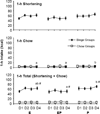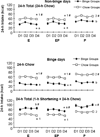Individual effects of estradiol and progesterone on food intake and body weight in ovariectomized binge rats
- PMID: 21801735
- PMCID: PMC3183279
- DOI: 10.1016/j.physbeh.2011.07.017
Individual effects of estradiol and progesterone on food intake and body weight in ovariectomized binge rats
Abstract
The individual roles of estradiol (E) and progesterone (P) in the control of food intake and body weight in ovariectomized (OVX) rats were investigated. Six groups of OVX Sprague-Dawley rats (n=9/group) were assigned to one of three 4-day cyclic hormone treatments: two groups were treated with E benzoate; two groups were treated with P; two groups were treated with both (EP). All rats had continuous access to chow and water throughout this 4-week study. One group of rats within each hormone treatment condition was fed chow ad libitum, and the second was subjected to a binge schedule: chow ad libitum plus 1-h access to an optional fat source on Monday, Wednesday, and Friday. A seventh OVX group (n=8) received the oil vehicle and chow. This group was included to monitor body weight and to verify hormone efficacy. The main findings were: (1) relative to rats receiving only P, E alone or EP attenuated 24-h chow intake tonically and cyclically, i.e. intake on Day 4, which models estrus, was lower in E and EP than in P, and also was lower than intake on Day 2, which models diestrus. In contrast, (2) neither E nor EP detectably affected optional fat intake during the 1-h fat access period relative to rats receiving only P when data were collapsed across the entire study. However, (3) E and EP had large effects on fat intake relative to P during the 1-h fat access period at the start of the study, but not at the end, when bingeing was fully established. (4) E and EP led to lower and apparently normal levels of body weight compared to rats receiving only the oil vehicle or only P. These results indicate that (1) administration of E alone has similar effects as co-administration of E and P on feeding and body weight in rats bingeing on fat, (2) with or without P, the inhibitory effects of E on meal size are compromised when bingeing on fat, and (3) the effects of E on binge size change dynamically as bingeing develops.
Copyright © 2011 Elsevier Inc. All rights reserved.
Figures




Similar articles
-
Ovarian hormones inhibit fat intake under binge-type conditions in ovariectomized rats.Physiol Behav. 2008 Oct 20;95(3):501-7. doi: 10.1016/j.physbeh.2008.07.021. Epub 2008 Jul 22. Physiol Behav. 2008. PMID: 18706435 Free PMC article.
-
2-Hydroxyestradiol enhances binge onset in female rats and reduces prefrontal cortical dopamine in male rats.Horm Behav. 2013 Jan;63(1):88-96. doi: 10.1016/j.yhbeh.2012.10.010. Epub 2012 Oct 29. Horm Behav. 2013. PMID: 23116652 Free PMC article.
-
Effects of estradiol on food intake and meal patterns for diets that differ in flavor and fat content.Physiol Behav. 2010 Jan 12;99(1):142-5. doi: 10.1016/j.physbeh.2009.10.009. Physiol Behav. 2010. PMID: 19840812 Free PMC article.
-
Hypothalamic implants of dilute estradiol fail to reduce feeding in ovariectomized rats.Physiol Behav. 2002 Nov;77(2-3):233-41. doi: 10.1016/s0031-9384(02)00857-0. Physiol Behav. 2002. PMID: 12419399
-
Estradiol and the control of food intake.Physiol Behav. 2010 Feb 9;99(2):175-80. doi: 10.1016/j.physbeh.2009.06.010. Epub 2009 Jun 23. Physiol Behav. 2010. PMID: 19555704 Free PMC article. Review.
Cited by
-
Binge Eating Risk During Midlife and the Menopausal Transition: Sensitivity to Ovarian Hormones as Potential Mechanisms of Risk.Curr Psychiatry Rep. 2023 Feb;25(2):45-52. doi: 10.1007/s11920-022-01405-5. Epub 2022 Dec 24. Curr Psychiatry Rep. 2023. PMID: 36565385 Free PMC article. Review.
-
Assessing binge eating. An analysis of data previously collected in bingeing rats.Appetite. 2012 Oct;59(2):478-82. doi: 10.1016/j.appet.2012.05.022. Epub 2012 May 26. Appetite. 2012. PMID: 22641146 Free PMC article.
-
Ovarian hormones and obesity.Hum Reprod Update. 2017 May 1;23(3):300-321. doi: 10.1093/humupd/dmw045. Hum Reprod Update. 2017. PMID: 28333235 Free PMC article. Review.
-
Ovarian Hormones and Binge Eating in Adulthood: Summary of Findings and Implications for Individual Differences in Risk in Women.Curr Dir Psychol Sci. 2023 Dec;32(6):471-478. doi: 10.1177/09637214231192835. Epub 2023 Sep 14. Curr Dir Psychol Sci. 2023. PMID: 38313831 Free PMC article.
-
Tea polyphenols attenuate liver inflammation by modulating obesity-related genes and down-regulating COX-2 and iNOS expression in high fat-fed dogs.BMC Vet Res. 2020 Jul 8;16(1):234. doi: 10.1186/s12917-020-02448-7. BMC Vet Res. 2020. PMID: 32641048 Free PMC article.
References
-
- Geary N. The estrogenic inhibition of eating. In: Sticker E, Woods SC, editors. Neurobiology of food and fluid intake. vol 14. New York: Kluwer Academic Publishing; 2004. pp. 305–343.
-
- Wade GN. Gonadal hormones and behavioral regulation of body weight. Physiol Behav. 1972;8:523–534. - PubMed
-
- Drewett RF. The meal patterns of the oestrous cycle and their motivational significance. Q J Exp Psychol. 1974;26:489–494. - PubMed
-
- Drewett RF. Oestrous and dioestrous components of the ovarian inhibition on hunger in the rat. Anim Behav. 1973;21:772–780. - PubMed
Publication types
MeSH terms
Substances
Grants and funding
LinkOut - more resources
Full Text Sources
Medical

